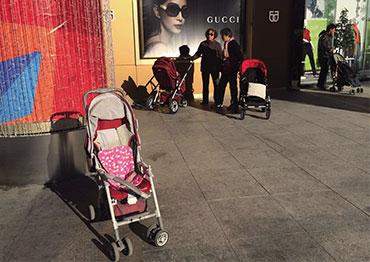Conducted in 2020, the seventh national census showed that seniors aged 65 and above account for 13.5 percent of the total population, almost double the rate in 2000 (6.89 percent) and about 5 percent higher than ten years ago in 2010 (8.87 percent).
According to an estimate from the Shanghai Academy of Social Sciences (SASS), the number of those aged 65 and above will account for 30 percent of China’s population in 2050, which would rank China alongside the world’s most aging countries such as Japan, South Korea and Singapore.
By contrast, China’s labor force, those aged between 16 and 59, has shrunk by 7 percent, or some 40 million within the last 10 years. One bright spot in the data is the proportion of children, or those aged 14 or younger, which increased slightly from 16.6 percent in 2010 to 18.0 percent in 2020. However, the trajectory of the annual number of new births in more recent years shows a worrying trend.
To boost the number of births, China allowed all families to have two children in 2016, the first major change in its family planning policy of 1979. The policy led to a surge in the number of births in the subsequent two years, increasing from 16.55 million in 2015 to over 18 million and 17 million in 2016 and 2017.
But the policy’s effect quickly subsided as the number of births dropped to 15.23 million and 14.65 in 2018 and 2019. In 2020, the figure further fell to about 12 million in 2020, 22 percent lower than the previous year.
In the past 10 years, average family size decreased from 3.10 people in 2010 to 2.62 in 2020. In 2020, China recorded a fertility rate of 1.3, well below the roughly 2.1 needed for replacement level.
In total, the population of the Chinese mainland in 2020 amounted to 1.412 billion, 72 million more than the 2010 census.
Accounting for 18 percent of the global population, China remains the most populous country in the world, but its population has been growing at a slower pace, an average of 0.53 percent each year, compared to an annual average of 0.57 percent in the 2001-2010 period and 1.07 percent from 1991-2000.
The census data serves to refute a report by newspaper the Financial Times which had cited a specific source and claimed that China’s population had already peaked and had in fact fallen in 2020.
However, the data does indicate that China’s population will peak much earlier than previously expected.
The United Nations predicted the population living in the Chinese mainland would peak by 2030. But according to a 2020 report released by the Evergrande Research Institute, a Shenzhen-based think tank, the country’s population will peak within five years at around 1.42 billion, which means that China could soon be surpassed by India, which had an estimated population of 1.38 billion in 2020, according to data website Statista.

 Old Version
Old Version

